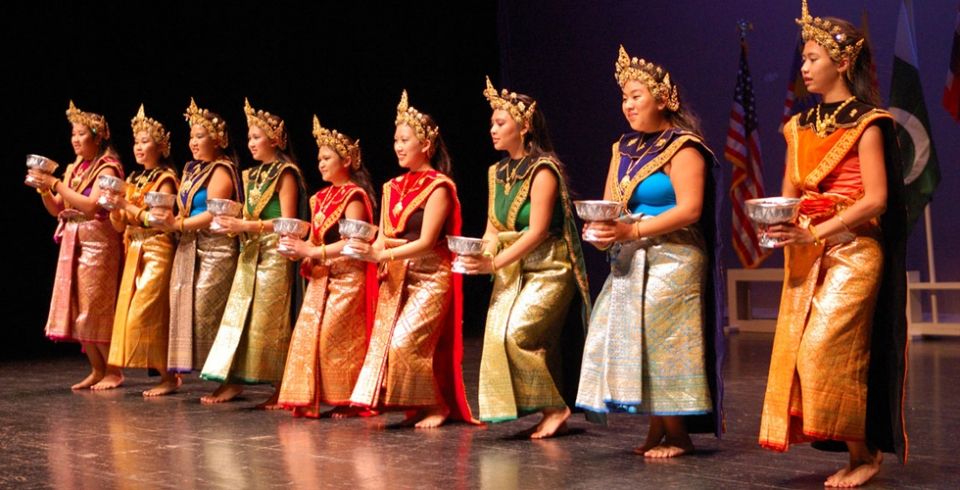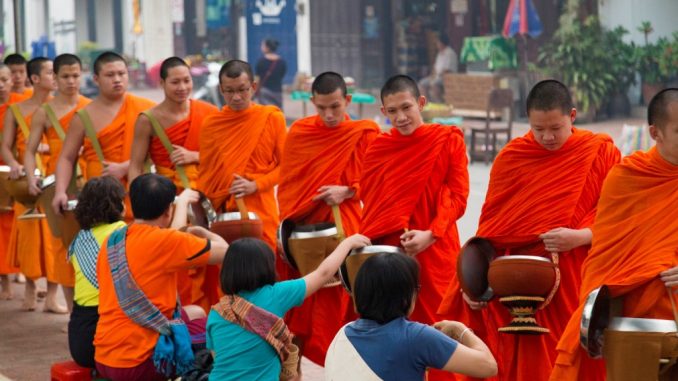.jpg)
Outstanding Universal Value
Brief synthesis
Luang Prabang is located in northern Laos at the heart of a mountainous region. The town is built on a peninsula formed by the Mekong and the Nam Khan River. Mountain ranges (in particular the PhouThao and PhouNang mountains) encircle the city in lush greenery.
Many legends are associated with the creation of the city, including one that recounts that Buddha would have smiled when he rested there during his travels, prophesying that it would one day be the site of a rich and powerful city. Known as Muang Sua, then Xieng Thong, from the 14th to the 16th century the town became the capital of the powerful kingdom of Lane Xang (Kingdom of a Million Elephants), whose wealth and influence were related to its strategic location on the Silk Route. The city was also the centre of Buddhism in the region. Luang Prabang takes its name from a statue of Buddha, the Prabang, offered by Cambodia.
After the establishment of the French Protectorate in 1893, following a period of turmoil during which the country was divided into three independent kingdoms, Luang Prabang once again became the royal and religious capital during the reign of King Sisavang Vong. It played this role until Vientiane became the administrative capital in 1946.
Luang Prabang is exceptional for both its rich architectural and artistic heritage that reflects the fusion of Lao traditional urban architecture with that of the colonial era. Its remarkably well-preserved townscape reflects the alliance of these two distinct cultural traditions.
The political and religious centre of Luang Prabang is the peninsula, with its royal and noble residences and religious foundations. The traditional urban fabric of the old villages, each with its temple, was preserved by later constructions. The colonial urban morphology, including the network of streets, overlapped harmoniously with the previous model. Formerly the town limits were defined by defensive walls.
The richness of Luang Prabang architecture reflects the mix of styles and materials. The majority of the buildings are, following tradition, wooden structures. Only the temples are in stone, whereas one- or two-storey brick houses characterize the colonial element of the town. The many pagodas or "Vat" in Luang Prabang, which are among the most sophisticated Buddhist temples in Southeast Asia, are richly decorated (sculptures, engravings, paintings, gilding and furniture pieces). Wat Xieng Thong, which dates from the 16th century, comprises an ensemble of the most complex structures of all the pagodas of the town. It is remarkable both from the archaeological point of view, and from the Lao iconographic and aesthetic viewpoint.
Many traditional Lao houses remain; they are built of wood using traditional techniques and materials introduced in the colonial period, such as plaited bamboo panels coated with wattle and daub. Brick colonial buildings, often with balconies and other decorative features in wood, line the main street and the Mekong.
The built heritage of Luang Prabang is in perfect harmony in the natural environment. The sacred Mount Phousi stands at the heart of the historic town built on a peninsula delimited by the Mekong and the Nam Khan, domain of the mythical naga. Ceremonies to appease the nagas and other evil spirits, and Buddhist religious practices (Prabang procession, the monks’ morning quest) perpetuate the sanctity of the place. Natural spaces located in the heart of the city and along the riverbanks, and wetlands (a complex network of ponds used for fish farming and vegetable growing) complement this preserved natural environment.
Criterion (ii): Luang Prabang reflects the exceptional fusion of Lao traditional architecture and 19th and 20th century European colonial style buildings.
Criterion (iv): Luang Prabang is an outstanding example of an architectural ensemble built over the centuries combining sophisticated architecture of religious buildings, vernacular constructions and colonial buildings.
Criterion (v): The unique townscape of Luang Prabang is remarkably well preserved, illustrating a key stage in the blending of two distinct cultural traditions.
Integrity
The integrity of the inscribed site is linked to an architectural and cultural heritage set in a natural landscape that reflects its Outstanding Universal Value. All of the significant elements, especially the urban fabric and major monuments (temples, public buildings, traditional houses), have been preserved.
However, there are some threats to the site due to the rapid development of the town and strong economic pressures, many of which are related to tourism (transformation of use of buildings, departure of residents, illegal construction).
Authenticity
The landscapes and urban fabric retain a high degree of authenticity, and the site is not disturbed by any major construction.
The religious buildings are regularly maintained; monks teach young monks restoration techniques for their heritage. Moreover, the Buddhist cult and the cultural traditions related to it (rites and ceremonies) are still alive and practiced diligently.
However, the degree of the authenticity of materials and construction techniques of many houses is low, since, for a long period, unsuitable modern techniques and materials (concrete, in particular) have often been used to replace traditional materials.
Frequently Questions Are Being Asked About Luang Prabang
1. Which Experiences Are Best For Tours In Luang Prabang?
These experiences are best for tours in Luang Prabang:
THE BEST LUANG PRABANG TOUR (3DAYS)
LUANG PRABANG-WORLD HERITAGE TOUR (5DAYS)
2. What Are The Best Places Plus With Tours In Luang Prabang?
These places are the best combine with Luang Prabang.
LAOS HIGHLIGHTS (10DAYS)
LAOS-GREEN ESCAPES (7DAYS)
3. Which Place Is Must See In Luang Prabang?
These places must see in Luang Prabang:
- Mount Phousi
- Royal Temple Museum
- Wat Xieng Thong
- Pha Tad Ke Botanical Gardens
- Butterfly Park
- UXO Laos Visitor's Center
- Traditional Arts and Ethnology Center
- Night Market
- Pak Ou Caves
- River Cruise


.jpg)



.jpg)


.jpg)


.jpg)
.jpg)


.jpg)










